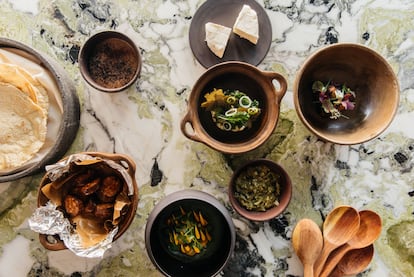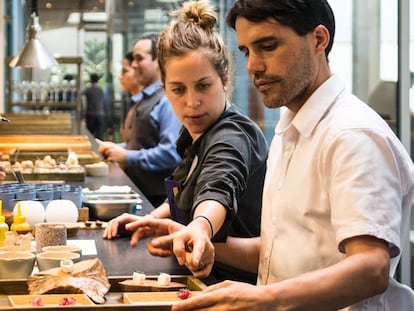How Mexican food has conquered the world’s haute cuisine
Some of Mexico’s leading chefs highlight the exclusivity of the local producers of its cuisine, first declared Intangible Cultural Heritage of Humanity
There are only four cuisines in the world that have been declared Intangible Cultural Heritage of Humanity. Mexican cuisine is not only one of them, but it was the first to achieve this designation from Unesco. Its colors, flavors and textures are part of a history spanning thousands of years in which cooking is an element of identity. International recognition came in 2010, despite the fact that it was only 20 years ago that culinary schools began to operate in the country. Jorge Vallejo, chef at Quintonil recalls: “The turning point was professionalization, and it was a domino effect because the professionals began to demand [other] professionals around them and that was also when there began to be professionals in the products and the appliances we use in the service,” he says.
EL PAÍS has brought together five of the best Mexican chefs in a conversation about the position of Mexican cuisine in the culinary world. They all participated at The World’s 50 Best Restaurants gala, held in Valencia last week, and three of them are head chefs at establishments included on that list. Jorge Vallejo (Quintonil), Elena Reygadas (Rosetta), Santiago Lastra (KOL), Jesús Durón (executive chef at Enrique Olvera’s Pujol restaurant) and Gustavo Garnica (from Cosme restaurant, also owned by Olvera) sat down to discuss the path their “dishes” have taken, which today are sampled as haute cuisine all over the world. They were accompanied by Valentina Ortiz Monasterio, president of Latin America’s 50 Best Restaurants. There were many points in common: from the pride in their Mexicanness and the exclusivity of some local produce, to the conviction of the quality and importance of the producers.
Santiago Lastra is the chef at the Michelin-starred London restaurant KOL. He has cooked in 30 countries, but always comes back to his own, as he himself says. He believes the boom started when chefs began to look inward and “value what we have.” “Over the years, we understood that the logical thing to do was Mexican cuisine,” Vallejo adds. “We had to look outside [Mexico] to value what we had inside,” agrees Jesús Durón, executive chef at Pujol, a restaurant that in this edition dropped from eighth to 13th place in the list of the World’s 50 Best Restaurants. And then they get started on talking about produce and preparing dishes. For Elena Reygadas, named the best Latin American cook, uniqueness has been essential: “You can eat a lobster in many places in the world, but not escamoles (ant larvae). It is a rural cuisine and it is the most beautiful. The tamale is a worthy dish, and we have distinguished it from other expensive products,” she says. “We have a range of colors that doesn’t exist in other cuisines and all the layers of flavor in one bite,” adds Vallejo, who points out that only Asian cuisine comes close to that diversity.
For Gustavo Garnica, chef at Cosme, the restaurant that Enrique Olvera owns in New York, Mexican cooking “is an honest cuisine that shows the complexity of simple things.” And among those simple things are tortillas and the corn from which they are made. It is said that children in Mexico smell them to check if they are made from good corn. And that at some birthday parties, coming of age is celebrated with a mole de guayaba at the request of the birthday boy or girl. Although they believe that “the world fits in a tortilla,” as Gustavo Garnica says, they have found that when they improve the quality of their raw materials, “demand grows because people understand that it is good,” as Durón explains.
Although they are aware that there was a time when the world thought Mexican cuisine was limited to tacos, they hold no grudge against those who have opened doors for them, even with Tex-Mex: “There is a Mexican restaurant called Lupita in every city. They are Tex-Mex, and we have a good reputation, they look at us with affection and have opened another door,” says Durón, who, in any case, points out that quality has been what has led them to the place they occupy in world cuisine. “The textures of the tortilla change depending on how the corn dries, and these are details that turn something traditional [into] something complex,” he explains.
They are all bursting with enthusiasm and pride. And they admit, almost as one, that “in the end, we believed it.” “We are chefs from different generations, but aware of our culinary history. We respect it, but we also complement it by proposing things that strengthen it,” argues Elena Reygadas. The fact is that there is a lot of camaraderie between them. “We are united and proud of our cuisine,” says Santiago Lastra.

Mexican chefs have not only succeeded abroad. They have also been prophets in their own land and, now, they are cultural ambassadors. “They are the big stars of the moment,” says Valentina Ortiz Monasterio, president of Latin America’s 50 Best Restaurants. And none of them has forgotten those who provide them with all the raw materials that make their dishes so different, authentic, and special. “We have to set the countryside on the pedestal it deserves,” says Santiago Lastra, who travels to Mexico from London from time to time to continue discovering how various herbs are used in the most remote parts of the country. “They are the real heroes,” he adds. Jesús Durón points out something else: the professionalization of the kitchen has also meant the professionalization of producers of ingredients such as organic corn, who have found an outlet in their home country and have forgotten about wanting to go to the United States to pursue the American dream.
None of them wants to die of success. And they work for it. “We have to teach children so that they know how to cultivate produce and have time to go back to making jams,” Durón proposes. “We are all responsible for taking care of our cuisine so that it is not lost, and that each generation improves it,” adds Gustavo Garnica. The chef of Quintonil, the ninth-best restaurant in the world, adds another ingredient: “Gastronomy is a transformational factor,” he says. And it’s not just about sustainability and respect for the ecosystem, but also about improving eating habits. And he sums up the whole conversation in one sentence: “There’s a hunger for Mexican cuisine.”
Sign up for our weekly newsletter to get more English-language news coverage from EL PAÍS USA Edition
Tu suscripción se está usando en otro dispositivo
¿Quieres añadir otro usuario a tu suscripción?
Si continúas leyendo en este dispositivo, no se podrá leer en el otro.
FlechaTu suscripción se está usando en otro dispositivo y solo puedes acceder a EL PAÍS desde un dispositivo a la vez.
Si quieres compartir tu cuenta, cambia tu suscripción a la modalidad Premium, así podrás añadir otro usuario. Cada uno accederá con su propia cuenta de email, lo que os permitirá personalizar vuestra experiencia en EL PAÍS.
¿Tienes una suscripción de empresa? Accede aquí para contratar más cuentas.
En el caso de no saber quién está usando tu cuenta, te recomendamos cambiar tu contraseña aquí.
Si decides continuar compartiendo tu cuenta, este mensaje se mostrará en tu dispositivo y en el de la otra persona que está usando tu cuenta de forma indefinida, afectando a tu experiencia de lectura. Puedes consultar aquí los términos y condiciones de la suscripción digital.
More information

Marsia Taha, the chef who made Bolivia eat alligators
Archived In
Últimas noticias
A hybrid building: Soccer pitch, housing, and a shopping mall
Europe urges Trump to respect Greenland following annexation threats
Science seeks keys to human longevity in the genetic mixing of Brazilian supercentenarians
Luisa Neubauer, climate change activist: ‘Ecology shouldn’t be a punitive force, but a joyful and liberating one’
Most viewed
- Alain Aspect, Nobel laureate in physics: ‘Einstein was so smart that he would have had to recognize quantum entanglement’
- Alvin Hellerstein, a 92-year-old judge appointed by Bill Clinton, to preside over Maduro’s trial in New York
- Cuba confirms death of 32 of its citizens in the US attack against Venezuela
- Gilles Lipovetsky: ‘If you want to live better and fall in love, take Prozac, don’t look to philosophy’
- Why oil has been at the center of Venezuela-US conflicts for decades










































